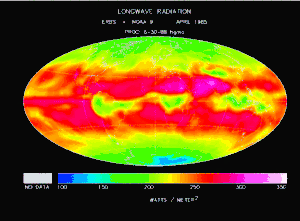Radiative cooling

Radiative cooling is the process by which a body loses heat by thermal radiation.
Terrestrial radiative cooling
Earth's energy budget
In the case of the Earth-atmosphere system radiative cooling is the process by which long-wave (infrared) radiation is emitted to balance the absorption of short-wave (visible) energy from the sun.
The exact process by which Earth loses heat is rather more complex than often portrayed. In particular, convective transport of heat, and evaporative transport of latent heat are both important in removing heat from the surface and redistributing it in the atmosphere. Pure radiative transport is more important higher up. Diurnal and geographical variation further complicate the picture.
The large-scale circulation of the Earth's atmosphere is driven by the difference in absorbed solar radiation per square meter, as the sun heats the Earth more in the Tropics, mostly because of geometrical factors. The atmospheric and oceanic circulation redistributes some of this energy as sensible heat and latent heat partly via the mean flow and partly via eddies, known as cyclones in the atmosphere. Thus the tropics radiate less to space than they would if there were no circulation, and the poles radiate more; however in absolute terms the tropics radiate more energy to space.
Nocturnal surface cooling
Radiative cooling is commonly experienced on cloudless nights, when heat is radiated into space from the surface of the Earth, or from the skin of a human observer. The effect is well-known among amateur astronomers, and can personally be felt on the skin of an observer on a cloudless night. To feel the effect, one compares the difference between looking straight up into a cloudless night sky for several seconds, to that of placing a sheet of paper between one's face and the sky. Since outer space radiates at about a temperature of 3 kelvins (-270 degrees Celsius or -450 degrees Fahrenheit), and the sheet of paper radiates at about 300 kelvins (room temperature), the sheet of paper radiates more heat to one's face than does the darkened cosmos. The effect is blunted by Earth's surrounding atmosphere, and particularly the water vapor it contains, so the apparent temperature of the sky is far warmer than outer space. Note that it is not correct to say that the sheet "blocks the cold" of the night sky; instead, the sheet is radiating heat to your face, just like a camp fire warms your face; the only difference is that a campfire is several hundred degrees warmer than a sheet of paper, just like a sheet of paper (at approximately air temperature) is warmer than the night sky.
The same radiative cooling mechanism can sometimes cause frost or black ice to form on surfaces exposed to the clear night sky, even when the ambient temperature does not fall below freezing.
Kelvin's estimate of the Earth's age
The term radiative cooling is generally used for local processes, though the same principles apply to cooling over geological time, which was first used by Kelvin to estimate the age of the Earth (although his estimate ignored the substantial heat released by radioisotope decay, not known at the time).
Astronomy
Radiative cooling is one of the few ways an object in space can give off energy. In particular, white dwarf stars are no longer generating energy by fusion or gravitational contraction, and have no solar wind. So the only way their temperature changes is by radiative cooling. This makes their temperature as a function of age very predictable, so by observing the temperature, astronomers can deduce the age of the star.[1][2]
Applications
Architecture
Cool roofs combine high optical reflectance with high infrared emissivity, thereby simultaneously reducing heat transfer from the sun and increasing heat removal through radiation. Radiative cooling thus offers immense potential for supplementary passive cooling to residential and commercial buildings.[3]
In 2017 researchers announced a metamaterial that embedded resonant polar dielectric microspheres randomly in a polymeric matrix. The material is transparent to the solar spectrum and achieved infrared emissivity greater than 0.93. When backed with silver coating, the material effected a midday radiative cooling power of 93 W/m2 under direct sunshine along with high-throughput, economical roll-to-roll manufacturing.[4]
Nocturnal ice making
In India before the invention of artificial refrigeration technology, ice making by nocturnal cooling was common. The apparatus consisted of a shallow ceramic tray with a thin layer of water, placed outdoors with a clear exposure to the night sky. The bottom and sides were insulated with a thick layer of hay. On a clear night the water would lose heat by radiation upwards. Provided the air was calm and not too far above freezing, heat gain from the surrounding air by convection was low enough to allow the water to freeze.[5]
See also
- Optical solar reflector, used for thermal control of spacecraft
- Passive cooling
- Radiative forcing
- Stefan-Boltzmann law
- Terrestrial albedo effect
- Urban heat island
- Urban thermal plume
References
- ↑ Mestel, L. (1952). "On the theory of white dwarf stars. I. The energy sources of white dwarfs". Monthly Notices of the Royal Astronomical Society. 112: 583–597. Bibcode:1952MNRAS.112..583M. doi:10.1093/mnras/112.6.583.
- ↑ "Cooling white dwarfs" (PDF).
- ↑ Hossain, Md Muntasir; Gu, Min (2016-02-04). "Radiative cooling: Principles, progress and potentials". Advanced Science. 3 (7): 1500360. doi:10.1002/advs.201500360. ISSN 2198-3844.
- ↑ Zhai, Yao; Ma, Yaoguang; David, Sabrina N.; Zhao, Dongliang; Lou, Runnan; Tan, Gang; Yang, Ronggui; Yin, Xiaobo (2017-03-10). "Scalable-manufactured randomized glass-polymer hybrid metamaterial for daytime radiative cooling". Science. 355 (6329): 1062–1066. Bibcode:2017Sci...355.1062Z. doi:10.1126/science.aai7899. ISSN 0036-8075. PMID 28183998.
- ↑ "Lesson 1: History Of Refrigeration, Version 1 ME" (PDF). Indian Institute of Technology Kharagpur. Archived from the original (PDF) on 2011-11-06.